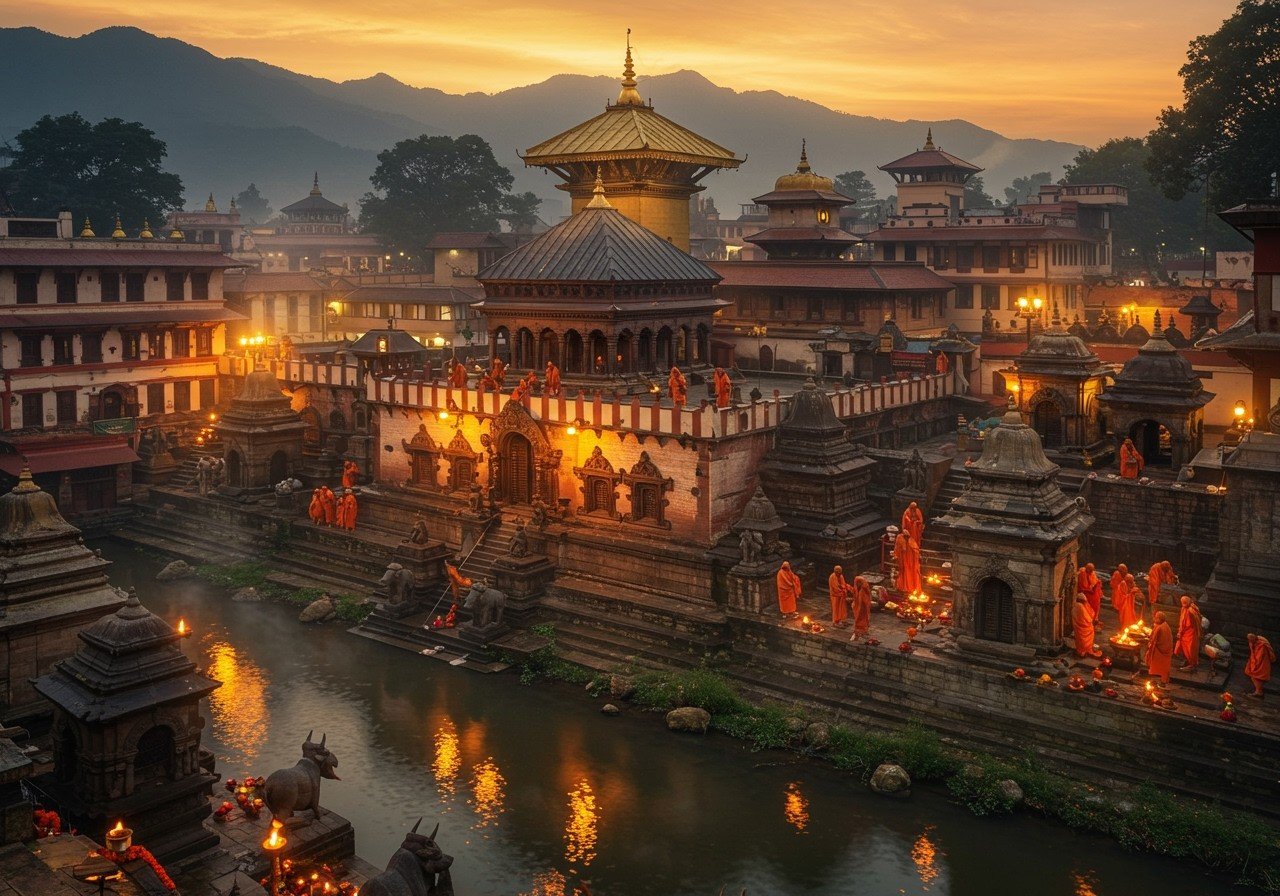
The Pashupatinath Temple stands as a beacon of spirituality and an architectural marvel, a revered symbol of Nepali heritage. A UNESCO World Heritage Site, it holds profound religious significance for Hindus worldwide. Nestled along the sacred Bagmati River in Kathmandu, Nepal, this temple serves as a major pilgrimage destination, dedicated to Lord Shiva. Its rich history, dating back to 400 AD, intertwines with a unique architectural style, establishing it as one of Nepal’s oldest and most cherished temples.
A Journey Through Time: History and Significance
The Pashupatinath Temple’s roots trace back to the 5th century, with significant renovations undertaken by the Malla kings. Legends, such as the tale of the cowherd and the divine lingam, enhance its spiritual aura. The temple’s recognition as one of the 12 Jyotirlingas further solidifies its status as a sacred abode of Lord Shiva. The Malla period significantly influenced the temple’s architecture, coinciding with a period of artistic flourishing. Pashupatinath plays a vital role in Nepal’s socio-cultural fabric, especially during festivals like Maha Shivaratri. Its designation as a UNESCO World Heritage Site in 1979 cemented its global cultural importance.
Architectural Splendor: Design and Style
Stepping into the Pashupatinath Temple is like entering a realm of traditional Nepalese pagoda-style architecture. This architectural gem showcases the rich artistry of Newari craftsmanship, a testament to Nepal’s cultural heritage.
- The Golden Roofs: Picture two tiers of copper roofs, gleaming with gold, a sight that embodies the spirit of Nepal. These majestic roofs rest upon a sturdy square base, reaching a height of 23 meters. The grandeur of the design speaks volumes about the skill and devotion of the artisans who created it. This is a truly awe-inspiring sight, capturing the essence of Nepalese architectural tradition.
Learn more about temple architecture. - The Silver Doors and Golden Pinnacle: As you approach, four main doors, covered in silver sheets, welcome you, symbolizing a passage to spiritual enlightenment. Above, a golden pinnacle shines brightly, drawing the gaze upwards in reverence. The silver and gold details create a striking contrast, emphasizing the temple’s sacred nature. These elements are not just decorative; they represent the spiritual journey towards enlightenment.
Compare different architectural styles. - The Sacred Sanctum: Inside, the inner sanctum exudes a sense of sacred tranquility. The two garbhagrihas—one enclosed and one open—create distinct yet connected spaces for worship and contemplation. The enclosed space houses the deity, while the open area allows for a communal experience of reverence. This unique arrangement highlights the temple’s inclusive spiritual approach.
Explore the architecture of Omkareshwar Temple. - The Mukhalinga and Nandi Bull: At the heart of the temple lies the Mukhalinga, a one-meter high stone idol with a silver base. It is encircled by a silver serpent and has faces in four directions, symbolizing various aspects of Lord Shiva. At the entrance of the inner sanctum stands a magnificent brass statue of Nandi Bull, the loyal gatekeeper of Shiva. This statue, with its imposing presence, embodies devotion and strength. The combination of the Mukhalinga and Nandi creates a powerful spiritual focal point within the temple.
Bring the divine presence home with a Shiva Murti. - The Wooden Carvings: Intricate wooden carvings adorn the temple structure, depicting deities and mythological scenes. Each carving tells a story, a testament to the ancient wisdom and artistic skill. These carvings not only beautify the temple but also serve as a visual narrative of Hindu mythology. They invite contemplation and offer a deeper understanding of the temple’s spiritual significance.
The architectural beauty of Pashupatinath Temple transcends the visual; it is a spiritual experience, connecting devotees with the divine. Through its design, one can feel the presence of Lord Shiva and the rich traditions of Nepal. It’s a timeless blend of art and faith.
Connecting with Sacred Traditions through Poojn.in
At Poojn.in, we offer authentic puja items that resonate with the sacred traditions of Pashupatinath Temple. As Lord Shiva is the presiding deity, we provide essential items for Shiva puja:
- Pure copper kalash for abhishekam rituals
- High-quality rudraksha malas
- Traditional dhoop and incense sticks
- Pure ghee diya for aarti
- Brass bells, reminiscent of those used in temple rituals
- Authentic panchamrit ingredients
- Pure silver items for abhishekam
To create a sacred space at home inspired by Pashupatinath, we also offer:
- Shiva lingam in various sizes
- Nandi idols
- Brass puja thalis
- Sacred thread (janeu)
- Gangajal in copper containers
All items are carefully selected to adhere to traditional standards and are shipped across India. Our experts are available via WhatsApp (9476142738) or phone (03369029784) to guide you in selecting the right puja items. Visit Poojn.in to explore our complete collection of authentic puja supplies for Shiva worship.
Note: All products mentioned are subject to availability. Please check our website for current stock and prices.
Conclusion: An Embrace of Art and Spirituality
Visiting Pashupatinath Temple is more than just admiring beautiful architecture; it’s an immersion into the spiritual heart of Nepal. The temple’s design, rich in symbolism and masterful craftsmanship, provides a serene sanctuary for reflection and devotion. Every detail, from the gleaming golden roofs to the intricate carvings, whispers tales of tradition and faith that have endured through time. As you explore this sacred masterpiece, you are enveloped by the divine energy of Lord Shiva and the artistry of the Newari artisans. It is a place where past and present converge, inviting everyone to experience a timeless connection with art and spirituality.
FAQs: Unraveling the Architectural Wonders of Pashupatinath
What distinguishes the architectural style of Pashupatinath Temple? The temple showcases the traditional Nepalese pagoda style, characterized by intricately carved wooden panels and a two-tiered roof adorned with golden finials.
Why is Pashupatinath Temple regarded as a masterpiece? The temple’s intricate woodwork, detailed metal sculptures, and the use of local materials contribute to its status as a sacred architectural masterpiece. Its design reflects the harmonious blend of nature and spirituality, unique to Nepalese heritage.
How does the temple’s design reflect Nepali culture? The design incorporates elements of Hindu symbolism, representing various deities and spiritual concepts integral to Nepali culture. The use of local craftsmanship further underscores Nepal’s rich cultural heritage and artistic traditions.
Are there any renowned drawings of Pashupatinath Temple? Yes, many artists and architects have captured the temple’s beauty and intricate details in their drawings. These artistic representations often focus on the temple’s facade and the intricate carvings that adorn its structure.
Can I find a model of Pashupatinath Temple? Models of Pashupatinath Temple are available in various forms, often crafted from materials like wood or metal. These models serve as popular souvenirs and educational tools, allowing admirers to appreciate the temple’s architecture up close. You can find beautifully crafted decorative items inspired by temple architecture at Poojn.in.
What materials were used in the temple’s construction? Stone, wood, and copper are the primary materials used in the construction of Pashupatinath Temple. These materials are meticulously crafted to create the intricate designs and carvings that define the temple’s unique architecture. We offer high-quality puja items crafted from similar traditional materials.
How do the carvings in Pashupatinath Temple convey a story? The carvings depict scenes from Hindu mythology, featuring gods, goddesses, and sacred animals. Each carving is a narrative element, adding depth and meaning to the temple’s spiritual significance. Explore our collection of handcrafted wooden masks depicting deities and mythological figures.
What is the significance of the pagoda style in the temple’s design? The pagoda style is significant as it represents the architectural tradition of the Kathmandu Valley. This style, with its tiered roofs and exquisite woodwork, is a hallmark of Nepali heritage. Find holy books and holy clothing to enhance your spiritual practice at Poojn.in.


